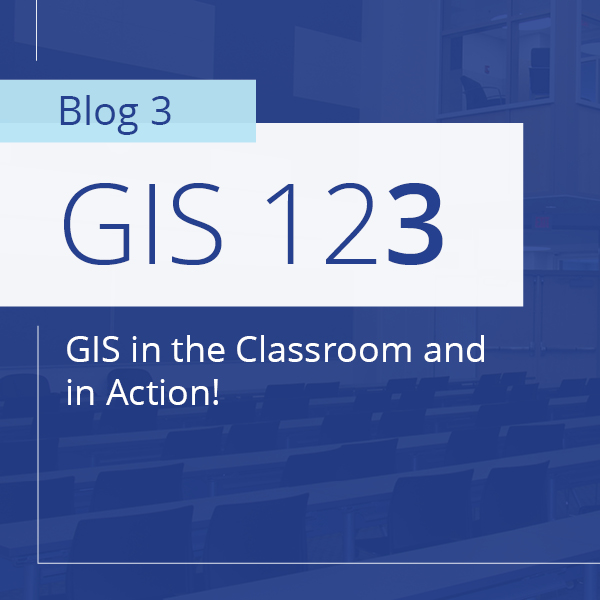GIS in the Classroom and in Action!

In GIS 1, we heard from an employee who reports to the client’s office instead of one of our own. Then, in GIS 2 we heard from two employees who both split their time between working in the field and in their offices. Welcome to GIS 3! We are hearing from Peter Erlenbach, who is working full time and earning his GIS masters.
Peter is a GIS specialist who graduated undergrad from Virginia Tech in 2018. Since then, he has worked full time with Colliers Engineering & Design. He is now simultaneously completing coursework to obtain the Master of Geospatial Information Science and Technology (MGIST) program from NC State University. Why did he want to tackle this challenge? He explained, “I heard a lot of positive feedback from people who completed the program, and I wanted to deepen my understanding of GIS.”
Should I Get My Masters?
Thinking of getting your masters? Peter has some advice for anyone contemplating taking that leap.
“First, make sure that this is something you want to do. It’s could take over your evenings and weekends for the duration of your degree, and you want to make sure that that’s something you are going to be okay with.”
He continued, “Then, you should look at how valuable this is going to be for you individually. I gave significant thought to how it could help me pursue my goals such as project management and business development. I then spoke with people within my network who were in those roles. And I asked their advice on whether a Masters would be valuable.”
For some positions and career progressions, getting a specific certification or certificate might make more sense than a masters. He emphasized to be sure to know what will make the most sense for you. It is, after all, a lot of time and it takes a lot of discipline and dedication. Fundamentals of Engineering (FE) is a certification that is the first step in the process to becoming a professional licensed engineer and takes 3 years. For some of Peter’s friends, that made more sense than pursuing their masters.
In addition to completing his Masters and working with Colliers Engineering & Design, Peter has completed a variety of Esri coursework and Massive Open Online Courses (MOOCs) regarding Python Scripting, Raster Analysis, ArcGIS Online, and Database Management.
A Day in the Life
 Peter usually works 40-45 hours a week for Colliers Engineering & Design in the firm’s Charlotte, North Carolina office. Like many of us, that usually looks like working 8-5, with an hour break for lunch. However, his lunch breaks look a little different than most. He usually spends them on homework, switching his focus entirely from work at 11:59 to homework at 12:00, then back to work at 1:00.
Peter usually works 40-45 hours a week for Colliers Engineering & Design in the firm’s Charlotte, North Carolina office. Like many of us, that usually looks like working 8-5, with an hour break for lunch. However, his lunch breaks look a little different than most. He usually spends them on homework, switching his focus entirely from work at 11:59 to homework at 12:00, then back to work at 1:00.
After work, he typically takes a small break to go for a run or breaks for dinner before refocusing again and doing work for his masters from roughly 8:00 to 10:00 at night.
Peter emphasized the importance of managing your time intentionally once you begin.
Time Management
Peter cited time management as the key to a successful outcome and explained that the biggest challenge is balancing the two workloads with mental health. “You learn a lot of the technical information in a master’s program, but the challenge is absorbing this information in a short and effective time frame.”
“It’s easy to get overwhelmed if you don’t manage your time wisely,” he shared. That is understandable, since he does the bulk of his masers work in the evenings and on weekends. “I carve out time for a golf game, to connect with friends, or a family event on a Saturday. If I know I am going to be occupied on a certain day, I evaluate my work and study schedule to ensure I have enough time to dedicate to both my school assignments and project deliverables. You’ll want to think about how many credits you can handle at a time. For example, a 3-credit hour class requires about nine hours of studying a week.”
He said, “I personally don’t do well sitting for forty hours straight so I take breaks to remain productive, and I have hard cut off times. For example, on weeknights I won’t work past 10pm, on a weekend 5pm. It’s important to set up strict boundaries.”
COVID
The pandemic enabled him to dedicate more time to the degree. With no commute, he can seamlessly switch between tasks and focuses. In a normal world without quarantine, he would have taken three credits a semester but is now taking nine because he has extra time.
“When the pandemic hit, I found myself with a lot of free time. Instead of watching Netflix, I took on more work, stacking more classes than I ever would have. It feels great to be using this time so productively.”
No commute, less social events and casual social situations all meant he could more easily focus on accelerating his degree. Completion of a master’s program usually takes 3.5 years while simultaneously working, or two years as a full-time student. Peter will be completing the MGIST program in two years. All while maintaining a 4.0 GPA and working full time.
Integration
His undergrad program prepared him well for the master’s program. Peter had a year and a half of working with CED between graduating undergrad and starting his master’s program. He entered the classes with experience and is expanding his understanding every day.
“What I’m learning now is more specialized when compared to my undergraduate education. I’m able apply what I am learning in a functional work environment. For example, I expanded my knowledge of Python for GIS (ArcPy) in my Masters program and brought that back to our GIS team. This helps our team learn new concepts and provide innovative solutions for our clients.” While working in his Masters program, Peter looks for ways to apply this knowledge to existing projects within Colliers Engineering & Design.
He explained that he learns things like web and mobile GIS, a strength of our group, from work. He feels added motivation to expand his knowledge through his MGIST program. Continually learning new applications for what he learns in his program only pushes him to excel further in both areas.
Good Decision?
Peter is very happy with his decision to pursue his masters while working at Colliers Engineering & Design. “The North Carolina State University MGIST program has challenged me to think outside the box, learn advanced geospatial concepts, technical writing for reports and proposals, and much more. Over the past year I have been able to take what I have learned from the program and apply it to my work environment. This has allowed to progress in my career path, take on new responsibilities, and even bring new ideas back to our team.”
He certainly is dedicated to furthering his career. However, he did mention that his coworker Amanda Paton, who was featured in GIS 2, said, “work to live, don’t live to work” to him when he started, and he has carried that sentiment with him.
This has been the final segment of our 3-part GIS series. Go back and read GIS 1 and GIS 2 if you missed them!


Comments are closed.